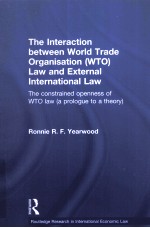

THE INTERACTION BETWEEN WORLD TRADE ORGANISATION(WTO)LAW AND EXTERNAL INTERNATIONAL LAWPDF电子书下载
- 电子书积分:10 积分如何计算积分?
- 作 者:RONNIE R.F.YEARWOOD
- 出 版 社:ROUTLEDGE
- 出版年份:2012
- ISBN:0415565162
- 页数:240 页
Prologue 1
0.1 Thie tragedy ofchoice: to write is to chioose 1
0.2 Thiere is no magic but in the pretence 7
0.3 Outliiie of my approach 8
0.4 Outline of my argument 19
0.5 Mr. Paloinar, Sisyphus and Alice 22
1 Introduction: the fragmented nature of international law 26
1.0 Introduction 26
1.1 Definitional sketch of fragmentation 28
1.2 Rational reconstruction 34
1.3 The rule of recognition 36
1.3.1 Tlhe internal point of view 37
1.3.2 Hart’s circularity 40
1.3.3 Dworkin’s challenge to Hart 43
1.4 The coumter -factual rule of recognition: the beginnings of a theory of WTO law 45
1.5 Conclusion 53
2 The inadequacy of the professional tool box of treaty interpretation as an account of fragmentation 55
2.0 Introduction 55
2.1 Lex specialis as an account of fragmentation nd WTO law 55
2.1.1 The problems with lex specialis as an account of fragmentation 57
2.2 Lex posterior as an account of fragmnentation and WTO law 58
2.2.1 The problems of lex posterior as an account of fragmentation: the example of WTO law and the Convention for International Trade in Endangered Species 60
2.3 Treaty inter pretation as an account of fragmentation and WTO law 61
2.3.1 The problems with the Vienna Convention on the Law of Treaties Articles 31 and 32 as an account of fragmentation 64
2.4. The interpretative approaches of the WTO adjudicating bodies 67
2.4.1 The example of EC— Biotech 69
2.5 Conclusion 74
3 The constrained openness of WTO law 75
3.0 Introduction 75
3.1 Thte continntation of building a theory of WTO law 76
3.2 The internal point of view ofthe WTO adjudicating bodies 80
3.2.1 The (re)construction of external international law into WTO law 85
3.2.2 The Petersmann-Alston debate 89
3.3 Fragmentation reconsidered 92
3.4 Indirectly and strategically influencing WTO law 95
3.5 Conclusion 101
4 The debate on the interaction between WTO law and external international law 103
4.0 Introduction 103
4.1 Model Ⅰ: WTO law as a limited domain 104
4.2 Model Ⅱ: WTO law as open 105
4.3 Model Ⅲ: WTO lae as privileged 106
4.4 The structural nature of the debate 107
4.5 Resolution ofconfict by superficial means 109
4.5.1 Modcls I and I1 on the purpose ofArticles 3.2 and 19.2 110
4.5.2 The distinction between jurisdiction and applicable law 111
4.5.3 Illustrating the debate 113
4.6 The constrained openness of WTO law: identifying the purpose of WTO law 114
4.6.1 Distilling the features of a theory: mapping constrained openness through Calvino’s Invisible Cities 123
4.7 Conclusion 126
5 The Precautionary principle and the WTO Agreement on Sanitary and Phytosanitary Measures 128
5.0 Introduction 128
5.1 The precautionary principle 129
5.2 The gateway approach for the in corporatiorn of the precautionary principle into WTO law 132
5.3 Overview of the SPS Agreerrment 133
5.3.1 Compliance with WTO/GATT is not necessarily an SPS defence 135
5.3.2 The ‘right’ to take an SPS measure 137
5.3.3 Definition and coverage of an SPS measure 138
5.3.4 Harmonisation of international standards and the SPS Agreement 141
5.3.5 The scientific requirements of the SPS Agreement 142
5.4 The precautionary principle and the texts of the SPS Agreemenl 145
5.5 The (re)construction of precaution as a variable in the practice of WTO law 148
5.5.1 EC- Hormones and initial thoughts on (re)construction of external international law 148
5.5.2 The scientific requirement to maintain an SPS measure 151
5.5.3 The two different definitions and evidentiary standards of risk assessment 154
5.5.4 The scientific risk assessment requirement ofArticle 5.1 and its relationship to Articlc 5.5 156
5.5.5 Insufficient evidence, showing uncertainty and the provisional SPS measure of Article 5.7 158
5.5.6 The right of a Member to set a higher level of SPS protection, standard of review and Article 3.3 162
5.5.7 Returning to EC - Horniones: (re)constructing precaution into a trade law variable 167
5.6 Rethinking the incorporation of the precautionary principle in WTO law 172
5.7 Conclusion 174
6 Examples of interaction between WTO law and external international law 175
6.0 Introduction 175
6.1 A bilateral agreenment: EC - Poultry 176
6.1.1 Case commentary: EC-Poultry 180
6.1.2 Case analysis: EC-Poultry 182
6.1.3 Summary: EC-Poultry 184
6.2 An agreement between a WTO Member and an international organisation: Argentina -Textiles and Apparels 185
6.2.1 Case commentary: Argentina - Textiles and Apparels 188
6.2.2 Case analysis: Argentina - Textiles and Apparels 189
6.2.3 Summary: Argentina- Textiles and Apparels 190
6.3 Law ‘nnot contracted out fron’: Korea - Government Procurement 191
6.3.1 Case commentary: Korea - Government Procurement 192
6.3.2 Case analysis and summary: Korea -Government Procurement 194
6.4 International environmental law to define WTO law: US - Shrimp 194
6.4.1 Case commentary: US -Shrimp 196
4.2 Summary: US-Shrimp 199
6.5 Potential cross conflict with another trade law system (North American Free Trade Area (NAFTA)): Mexico- Soft Drinks 199
6.5.1 Case commentary: Mexico -Soft Drinks 204
6.5.2 Case analysis: reflexive law and developing strategies for influencing WTO law 205
6.6 Conclusion 209
7 Conclusion 211
Selected bibliography 219
Index 234
- 《变革之声 参与式监测与评估在中国的实践》(加)罗尼·魏努力(Ronnie Vernooy),孙秋,许建初原编著;周丕文等译 2005
- 《信息化平面设计》(美)Ronnie Lipton编著;陈君等译 2003
- 《PRINCIPLES OF MANAGERIAL ECONOMICS》J.RONNIE DAVIS 1985
- 《MATHEMATICAL MODELING IN CHEMICAL ENGINEERING》RONNIE ANDERSSON 2014
- 《PRINCIPLES OF PUBLIC FINANCE》J.RONNIE DAVIS CHARLES W.MEYER 2222
- 《THE INTERACTION BETWEEN WORLD TRADE ORGANISATION(WTO)LAW AND EXTERNAL INTERNATIONAL LAW》RONNIE R.F.YEARWOOD 2012
- 《Existentialist criminology》Ronnie Lippens and Don Crewe (eds.). 2009
- 《WHAT IS CRIMINOLOGY ABOUT?》DON CREWE AND RONNIE LIPPENS 2015
- 《种子带来的生机 参与式植物育种》(加)罗尼·魏努力(Ronnie Vernooy)著;宋一青译 2003
- 《飞越迷梦 奥沙利文自传》(英)罗尼·奥沙利文(Ronnie OSullivan),(英)西蒙·哈顿斯通著;路旦俊,林英译 2006
